Getting started with IonSim
Contents
Getting started with IonSim#
What does IonSim do?#
IonSim is built on top of QuantumOptics.jl[KramerPOR18] and is primarily intended to simulate the following general system:
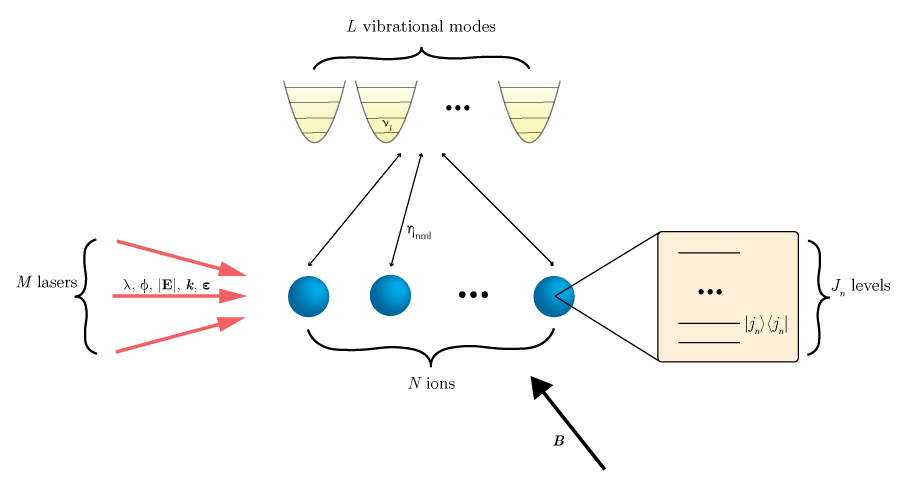
Fig. 1 A laser shining on a linear chain of trapped ions.#
or similar systems with different center of mass configurations. In an appropriate rotating frame, the Hamiltonian for the system in Fig. 1 is given by:
Variable definitions:
\(\pmb{\Omega_{nm} \cdot g(m, k_n, j_n)}\) describes the coupling between the \(m^{th}\) laser and the \(n^{th}\) ion’s \(|k_n\rangle \leftrightarrow | j_n \rangle\) transition (\(\Omega_{nm}\) depends on the intensity of the laser at the ion’s position and \(g\) is a geometric factor that depends on the details of the laser and transition.)
\(\pmb{\hat{\sigma}_{n,k_n,j_n}} = |k_n\rangle\langle j_n|\)
\(\pmb{\bar{\Delta}_{nmk_nj_n}}\) is the average detuning of the m\(^{th}\) laser from \(|k_n\rangle \leftrightarrow | j_n \rangle\).
\(\pmb{\phi_m}\) is the initial phase of the \(m^{th}\) laser.
\(\pmb{\eta_{nml}}\) is the Lamb-Dicke factor for the particular ion, laser, mode combination.
\(\pmb{\hat{a}_l}\) is the Boson annihilation operator the the \(l^{th}\) mode.
\(\pmb{\bar{\nu}_l}\) is the average vibrational frequency for the \(l^{th}\) mode.
To enable simulation of the above system, IonSim performs two main tasks:
Keeps track of the parameters and structure of the Hamiltonian according to user inputs
Given these inputs, constructs a function that efficiently returns the numerical representation of the Hamiltonian as a function of time.
The Hamiltonian function can then be used as input to one of the various QuantumOptics.jl differential equation solvers.
1) is accomplished with the use of Julia structs.
For reference, a map of these structs and their relationships is shown below.

Fig. 2 Organization of system parameters.#
2) is mainly handled in hamiltonians.jl.
How it works#
We’ll demonstrate the basics by walking you through some simple examples.
Load necessary modules#
When starting a new notebook, the first thing we have to do is load in the relevant modules.
using Revise
using IonSim
using QuantumOptics: timeevolution, stochastic, Basis
using Pkg
Pkg.add("StochasticDiffEq")
Pkg.add("DSP")
We’ll also load PyPlot (an interface to Python’s matplotlib), which we’ll need later
import PyPlot
const plt = PyPlot;
# set some plot configs
plt.matplotlib.rc("xtick", top=false)
plt.matplotlib.rc("ytick", right=false, left=false)
plt.matplotlib.rc("axes", labelsize=20, titlesize=20, grid=true)
plt.matplotlib.rc("axes", linewidth=2)
plt.matplotlib.rc("grid", alpha=0.25, linestyle="--")
plt.matplotlib.rc("font", family="Palatino", weight="medium")
plt.matplotlib.rc("figure", figsize=(8,4))
plt.matplotlib.rc("xtick.major", width=2)
plt.matplotlib.rc("ytick.major", width=2)
Defining the system#
First we’ll create an ion:
ca = Ca40([("S1/2", -1/2), ("D5/2", -1/2)])
print(typeof(ca) <: Ion)
true
print(ca)
⁴⁰Ca
("S1/2", -1//2)
("D5/2", -1//2)
As shown, Ca40 is a composite type derived from the abstract type Ion. We have given the argument [("S1/2", -1/2), ("D5/2", -1/2)] to the constructor, which is a vector of tuples. Each element of this vector specifies an electronic state. By specifying the two states ("S1/2", -1/2) and ("D5/2", -1/2), we’ve decided to include only these two electronic states in the Hilbert space.
To see all of the options for Ca40 we can look at its doc string, which can be accessed in Julia by typing ? before the variable name:
?Ca40
IonInstance(selected_sublevels::Vector{Tuple}[, manualshift::Dict]) Ion instance of species Ca40
selected_sublevels specifies which energy sublevels will be present in the Hilbert space of this Ion instance, as a subset of all possible sublevels.
Each element of selected_sublevels is a 2-element Tuple (level::String, sublevels), with the first element being the name of a level and the second specifying which sublevels should be included.
Allowed sublevels are those whose magnetic quantum number m is in the set {-f, -f+1, -f+2, … f-1, f}, where f is the total angular momentum quantum number of level.
For each level specified there are three allowed options to specify the set of sublevels to include:
sublevels::Real: Includes only onem = sublevelssublevels::Vector{Real}: Includes all sublevels whose magnetic quantum numbermis insublevelssublevels = "all": Includes all allowed sublevels If an element ofselected_sublevelsutilizes the first option, specifying a singlem, one may optionally may this a 3-element tuple instead:(level::String, m::Real, alias::String), assinging this particular sublevel the aliasalias.
Omission of a level in selected_sublevels will exclude all sublevels.
Fields
speciesproperties::NamedTuple: Contains constants specifying parameters specific to speciessublevels::Vector{Tuple{String,Real}}: List of all sublevels present in the Hilbert spacesublevelaliases::Dict{String,Tuple}: Dict specifying aliases assigned to sublevels, in the formatalias => sublevelshape::Vector{Int}: Dimension of the Hilbert spacemanualshift::OrderedDict: A dictionary with keys denoting the selected levels and values, a real number for describing a shift of the level’s energy. This is just a convenient way to add manual shifts to the simulation, such as Stark shifts off of energy levels not present in the Hilbert space, without additional resourcesionnumber: When the ion is added to anIonTrap, this value keeps track of its orderionposition: When the ion is added to anIonTrap, this value keeps track of its physical position in meters
In IonSim, electronic energy levels are labelled with a string (e.g. "S1/2" in Ca40), and their magnetic sublevels are labelled with a Tuple{String, Real} where the string is the energy level label and the real number is the magnetic quantum number. For example, the "S1/2" energy level of Ca40 has two possible magnetic sublevels, ("S1/2", -1//2) and ("S1/2", 1//2).
Use of these tuples can get cumbersome, so IonSim allows you to assign aliases to sublevels, allowing you to refer to them by any convenient String.
This can be done upon instantiation of the Ion struct. When specifying a sublevel to include in the Hilbert space, we give the corresponding tuple a third element, which is the String specifying the desired alias.
ca = Ca40([("S1/2", -1/2, "S"), ("D5/2", -1/2, "D")])
print(ca)
⁴⁰Ca
("S1/2", -1//2): "S"
("D5/2", -1//2): "D"
The print function now shows us the assigned aliases to each sublevel in the Ion’s Hilbert space. These may also be returned with the function sublevelaliases:
?sublevelaliases
search: sublevelaliases sublevelalias! sublevelalias clearsublevelalias!
sublevelaliases(ion::Ion)
Returns a Dict specifying all aliases assigned to sublevels of ion, in the format alias => sublevel, ion.sublevelalias
sublevelaliases(ca)
Dict{String, Tuple} with 2 entries:
"S" => ("S1/2", -1//2)
"D" => ("D5/2", -1//2)
Next we’ll define a Laser:
laser = Laser()
print(laser)
λ: missing m
Δ: 0 Hz
̂ϵ: (x=0.7071067811865475, y=0.7071067811865475, z=0.0)
k̂: (x=0, y=0, z=1)
I(t=0): 0 W/m²
ϕ(t=0): 0.0 ⋅ 2π
As shown, the default wavelength of Laser is set to missing. Typically, one wishes to set a laser wavelength at or near resonance with a particular atomic transition. We will do this later once we have set up the rest of the system.
To include the center of mass motion of the ion in our simulation, we need to add it to an IonTrap:
chain = LinearChain(
ions=[ca],
comfrequencies=(x=3e6,y=3e6,z=1e6),
selectedmodes=(;z=[1])
)
print(typeof(chain) <: IonTrap)
true
LinearChain automatically computes the normal modes for a collection of ions (as input to keyword argument ions) in a linear Coloumb crystal with the given center of mass frequencies. By setting selectedmodes=(;z=[1]) we’ve decided to only consider the 1st normal mode along the ẑ-direction.
modes(chain)
1-element Vector{VibrationalMode}:
VibrationalMode(ν=1.0e6, axis=ẑ, N=10)
The last thing we need to construct is a Chamber, which collects all of these objects that we’ve defined.
chamber = Chamber(iontrap=chain, B=4e-4, Bhat=ẑ, δB=0, lasers=[laser]);
A Chamber specifically associates an IonTrap and a set of lasers. It keeps track of which lasers point at which ions and with how much scaled strength (to model e.g. crosstalk). It also keeps track of the magnetic field. In this case we’ve set the magnetic field to have a strength of 4 Gauss and to point in the ẑ-direction. δB can be used to model a time-dependent magnetic field, which for example, might be useful to model noise – for now we set it to 0.
The Hilbert space of a trapped-ion system is made up of a tensor product of the internal electronic states and the states of the vibrational motion. The structs Ion and VibrationalMode are therefore both Bases, derived from the Basis struct in QuantumOptics.jl. They are both of the abstract type IonSimBasis, which captures all bases in IonSim.
println(IonSimBasis <: Basis)
println(Ion <: IonSimBasis)
println(VibrationalMode <: IonSimBasis)
true
true
true
Since the Chamber struct combines Ions with VibrationalModes, it also has a Hilbert space, whose basis is a CompositeBasis, a tensor product of its constituent bases:
basis(chamber)
[⁴⁰Ca
⊗ VibrationalMode(ν=1.0e6, axis=ẑ, N=10)]
Note
Though, mathematically, Ion ⊗ VibrationalMode is equivalent to VibrationalMode ⊗ Ion, when converted to the space of 2D matrices the description of these two bases will be different. Equivalence is maintained provided that the order is consistent throughout the description of the problem, but this requires us to set a convention. For a trap composed of a linear chain of ions, IonSim’s convention is: ion₁ ⊗ ion₂ ⊗ … ⊗ ionₙ ⊗ mode₁ ⊗ mode₂ ⊗ … ⊗ modeₙ, where the ion bases are ordered according to the order in ions(chamber) and the vibrational modes are ordered according to the order in [xmodes(chamber), ymodes(chamber), zmodes(chamber)].
Simulating basic dynamics#
Carrier Rabi oscillations#
Let’s start off by simulating rabi oscillations between the two considered states of our ion. First we have to update some of the parameters in our system.
First let’s set the wavelength of our laser. Here we want to set the wavelength such that the laser is resonant with the "S" -> "D" transition in the Ion ca. This can be done with the function transitionwavlength and passing in the arguments ca (the ion), ("S", "D") (the transition), and chamber (the Chamber in which ca resides). By including chamber in our function call, the function transitionwavlength takes into account the energy shift due to the magnetic field inside chamber.
The function wavelength! then sets the laser’s wavelength.
λ = transitionwavelength(ca, ("S", "D"), chamber)
wavelength!(laser, λ)
print(wavelength(laser))
7.291469960190796e-7
These two operations can also be done in a single function wavelength_from_transition!
wavelength_from_transition!(laser, ca, ("S", "D"), chamber)
7.291469960190796e-7
Due to selection rules and because we’ve defined our magnetic field to point in the ẑ-direction we need to update the geometry of our laser to have a nonzero coupling to this transition:
polarization!(laser, (x̂ - ẑ)/√2)
wavevector!(laser, (x̂ + ẑ)/√2);
Finally, we should set the laser’s intensity (at the position of the ion) to something reasonable. For this we use the convenience function intensity_from_pitime!
intensity_from_pitime!(laser, 2e-6, ca, ("S", "D"), chamber); # Sets pi_time to 2 μs
?intensity_from_pitime
?intensity_from_pitime!
search: intensity_from_pitime! intensity_from_pitime
intensity_from_pitime!(
laser::Laser, pi_time::Real, ion::Ion, transition::Tuple,
Bhat::NamedTuple{(:x,:y,:z)}
)
intensity_from_pitime!(
laser, pi_time::Real, ion, transition::Tuple, chamber::Chamber
)
Same as intensity_from_pitime, but updates laser[:I] in-place.
The last thing we need to do before we run our simulation is to construct the hamiltonian:
?hamiltonian
hamiltonian(
chamber::Chamber; timescale::Real=1, lamb_dicke_order::Union{Vector{Int},Int}=1,
rwa_cutoff::Real=Inf, displacement="truncated", time_dependent_eta=false
)
Constructs the Hamiltonian for `chamber` as a function of time. Return type is a function
`h(t::Real, ψ)` that, itself, returns a `QuantumOptics.SparseOperator`.
**args**
* `timescale`: e.g. a value of 1e-6 will take time to be in ``\\mu s``
* `lamb_dicke_order`: Only consider terms that change the phonon number by up to this value.
If this is an `Int`, then the cutoff is applied to all modes. If this is a `Vector{Int}`,
then `lamb_dicke_order[i]` is applied to the iᵗʰ mode, according to the order in
`basis(chamber)`.
Note: this isn't quite the same thing as the Lamb-Dicke approximation since setting
`lamb_dicke_order=1` will retain, for example, terms proportional to ``a^\\dagger a ``.
* `rwa_cutoff`: drop terms in the Hamiltonian that oscillate faster than this cutoff.
* `displacement`: This can be either `"truncated"`(default) or `"analytic"`.
When an atom is irradiated, both the atom's energy and its momentum will generally be
affected. For an atom in a harmonic potential, the exchange of momentum can be modeled as
a displacement operation ``D(α=iηe^{-iνt}) = exp[αa^† - α^*a]``, where ``η`` is the
Lamb-Dicke parameter, which can be described equivalently as either being proportional to
the square root of the ratio of the recoil frequency with the ground state energy of the
atom's motion or as the ratio of the spread of the ground state wavefunction to the
wavelength of the laser.
When `"truncated"` is selected, the matrix elements of ``D(α)`` are computed by
constructing ``α^* a, αa^†`` in a truncated basis (according to the dimension specified in
your model) and then exponentiating their difference. This has the advantage, amongst
other things, of guaranting unitarity.
If `"analytic"` is selected, then the matrix elements are computed assuming an infinite-
dimensional Hilbert space.
For small displacements (``η ≪ N``, where ``N`` is the dimension of the motion's Hilbert
space), both of these methods will be good approximations.
* `time_dependent_eta::Bool`: In addition to impacting the vibrational subspace directly, a
change in the trap frequency, ``δν``, will also change the Lamb-Dicke parameter. Since
typically ``δν≪ν``, this effect will be small ``η ≈ η₀(1 + δν/2ν)`` and doesn't warrant
the additional computational resources needed to calculate and update it in time. In this
case, we can set `time_dependent_eta=false` (default), which will set ``η(t) = η₀``.
h = hamiltonian(chamber, timescale=1e-6);
Finally, we need to construct and initial state of our system. As shown above, the basis is ⁴⁰Ca ⊗ VibrationalMode(ν=1.0e6, axis=ẑ, N=10), so we need to construct a state of this form.
For the Ion, an electronic eigenstate can be constructed either by indexing with the sublevel, or with the function ionstate.
ion = ions(chamber)[1]
ψ0_ion_1 = ion["S"]
ψ0_ion_2 = ion[("S1/2", -1/2)]
ψ0_ion_3 = ionstate(ion, "S")
print(ψ0_ion_1)
Ket(dim=2)
basis: ⁴⁰Ca
1.0 + 0.0im
0.0 + 0.0im
ψ0_ion_1 == ψ0_ion_2 == ψ0_ion_3
true
For the VibrationalMode, a Fock state can be constructed either by indexing or by the function fockstate. In the special case of the ground state, one may use the function groundstate.
mode = modes(chamber)[1]
ψ0_mode_1 = mode[0]
ψ0_mode_2 = fockstate(mode, 0)
ψ0_mode_3 = groundstate(mode)
print(ψ0_mode_1)
Ket(dim=11)
basis: VibrationalMode(ν=1.0e6, axis=ẑ, N=10)
1.0 + 0.0im
0.0 + 0.0im
0.0 + 0.0im
0.0 + 0.0im
0.0 + 0.0im
0.0 + 0.0im
0.0 + 0.0im
0.0 + 0.0im
0.0 + 0.0im
0.0 + 0.0im
0.0 + 0.0im
ψ0_mode_1 == ψ0_mode_2 == ψ0_mode_3
true
We can create a ket for the composite system with the tensor operator ⊗ (\otimes)
ψ0 = ion["S"] ⊗ mode[0];
Now we can take h and feed it into one of the QuantumOptics.timeevolution solvers:
ex = expect(ionprojector(chamber, "D"), sol)
plt.plot(tout, ex)
plt.xlim(tout[1], tout[end])
plt.ylim(0, 1)
plt.ylabel("Excitation")
plt.xlabel("Time (μs)");
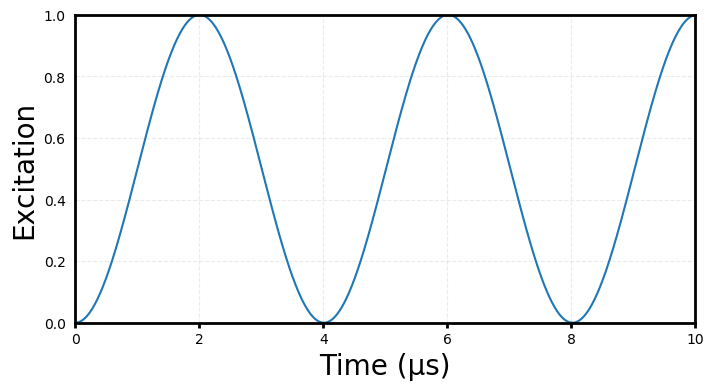
In the above plot, we see Rabi oscillations with a pi-time of 2 μs, as expected.
Now if we add a detuning to the laser equal to the Rabi frequency, we should see oscillation with half the amplitude and √2 times the frequency:
detuning!(laser, 2.5e5)
h = hamiltonian(chamber, timescale=1e-6)
@time tout, sol = timeevolution.schroedinger_dynamic(tspan, ψ0, h)
ex = expect(ionprojector(chamber, "D"), sol)
plt.plot(tout, ex)
plt.xlim(tout[1], tout[end])
plt.ylim(0, 1)
plt.ylabel("Excitation")
plt.xlabel("Time (μs)");
0.031658 seconds (81.04 k allocations: 2.601 MiB)
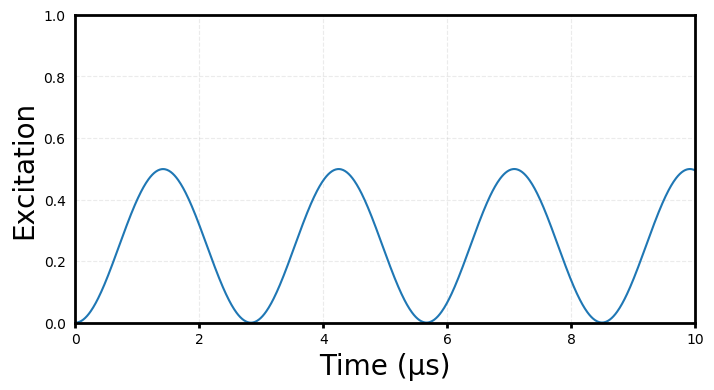
We can achieve the same effect by instead setting a nonzero value in our ion’s manualshift field. This can be useful when we have several ions in our chain and want to simulate some energy shift, for example an AC Stark shift, without involving an additional laser resource.
detuning!(laser, 9)
manualshift!(ca, "S", -1.25e5)
manualshift!(ca, "D", 1.25e5)
h = hamiltonian(chamber, timescale=1e-6)
@time tout, sol = timeevolution.schroedinger_dynamic(tspan, ψ0, h)
ex = expect(ionprojector(chamber, "D"), sol)
plt.plot(tout, ex)
plt.xlim(tout[1], tout[end])
plt.ylim(0, 1)
plt.ylabel("Excitation")
plt.xlabel("Time (μs)");
0.031258 seconds (95.15 k allocations: 2.970 MiB)
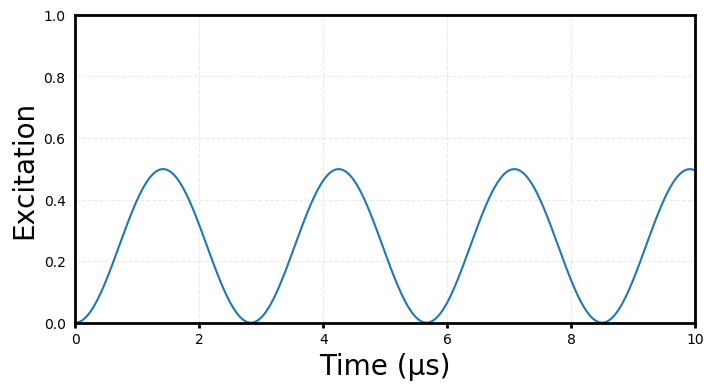
So far our simulations have used an initial state ionstate(ca, "S") ⊗ fockstate(mode, 0), or \(|S, n=0\rangle\), but we can also start off with the vibrational mode in a thermal state.
Let’s start by increasing the dimensionality of the VibrationalMode by changing the maximum N from 10 to 100.
modecutoff(mode)
10
modecutoff!(mode, 100)
modecutoff(mode)
100
# reset all manual shifts to zero
zeromanualshift!(ca)
# create initial state in terms of denisty matrices
ψi_ion = dm(ca["S"])
ψi_mode = thermalstate(mode, 10)
ψi = ψi_ion ⊗ ψi_mode
tspan = 0:0.1:50
h = hamiltonian(chamber, timescale=1e-6, rwa_cutoff=Inf, time_dependent_eta=false, displacement="truncated")
@time tout, sol = timeevolution.schroedinger_dynamic(tspan, ψi, h);
96.818914 seconds (26.84 M allocations: 2.286 GiB, 1.63% gc time, 22.27% compilation time)
We can compare this result with the analytical expression which can be found in IonSim’s analytical module:
?analytical.rabiflop
rabiflop(tspan, Ω::Real, η::Real, n̄::Real; s::Int=0)
Single ion rabi flop. Returns: $\( \sum_{n=0}^∞ p_n sin^2(\Omega_n t) \)\( with \)\( \Omega_n = Ωe^{-η^2/2}η^s\sqrt{\frac{n!}{(n+s)!}}L_{n}^{s}(η^2) \)\( where ``s`` is the order of the (blue) sideband that we are driving and \)L_{n}^{s}$ is the associated Laguerre polynomial. ref
ex = expect(ionprojector(chamber, "D"), sol)
plt.plot(tout, ex, label="numerical")
η = lambdicke(mode, ca, laser)
plt.plot(
tout, analytical.rabiflop(tout, 1/4, η, 10),
linestyle="--", label="analytical"
)
plt.xlim(tout[1], tout[end])
plt.ylim(0, 1)
plt.legend(loc=1)
plt.ylabel("Excitation")
plt.xlabel("Time (μs)");
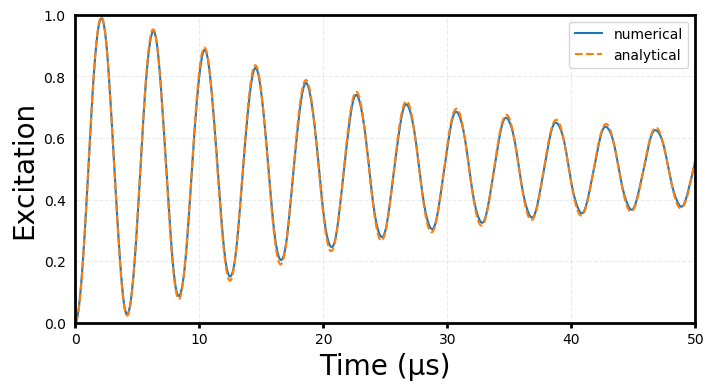
We see good, but not perfect agreement between the two curves. In fact, the majority of this discrepancy comes from off-resonant interaction with the first order sideband which the simulation captures but the analytical solution does not.
This can be confirmed by eliminating this off-resonant interaction in our simulation by setting they keyword argument lamb_dicke_order in the hamiltonian function to zero (by default, this is set to 1).
h = hamiltonian(chamber, timescale=1e-6, lamb_dicke_order=0) # set lamb_dicke_order here
@time tout, sol = timeevolution.schroedinger_dynamic(tspan, ψi, h);
114.648591 seconds (722.29 k allocations: 342.144 MiB, 0.66% gc time, 0.01% compilation time)
ex = expect(ionprojector(chamber, "D"), sol)
plt.plot(tout, ex, label="numerical")
η = lambdicke(mode, ca, laser)
plt.plot(
tout, analytical.rabiflop(tout, 1/4, η, 10),
linestyle="--", label="analytical"
)
plt.xlim(tout[1], tout[end])
plt.ylim(0, 1)
plt.legend(loc=1)
plt.ylabel("Excitation")
plt.xlabel("Time (μs)");

Which gives a much better agreement between the two curves.
At this point, it’s worth explaining in more detail what we’ve just done. Conventionally, we would probably guess that setting the lamb_dicke_order to n would be equivalent to truncating the Taylor series expansion of the displacement operator \(D(iη e^{iνt})\) after the \(n^{th}\) order in η.
But this is not what IonSim does. Instead, it just drops all (Fock basis) matrix elements of \(\langle m | D | n \rangle\) where \(|m-n| > n\).
All matrix elements of the operator are computed analytically. So, for example, even if we set lamb_dicke_order=0, we’ll still retain the precise effect that the mode coupling has on the carrier transition – as in the above example.
Sideband Transitions#
Let’s see some examples of driving sideband transitions:
tspan = 0:0.1:100
# set the motional dimension back to 10
modecutoff!(mode, 10)
# tune laser frequency to blue sideband
ν = frequency(mode)
detuning!(laser, ν)
h = hamiltonian(chamber, timescale=1e-6)
@time tout, sol_blue = timeevolution.schroedinger_dynamic(tspan, ψ0, h)
# tune laser frequency to red sideband
detuning!(laser, -ν)
h = hamiltonian(chamber, timescale=1e-6)
@time tout, sol_red = timeevolution.schroedinger_dynamic(tspan, ψ0, h)
ex_blue = expect(ionprojector(chamber, "D"), sol_blue)
ex_red = expect(ionprojector(chamber, "D"), sol_red)
plt.plot(tout, ex_blue, color="blue", label="blue sideband")
plt.plot(tout, ex_red, color="red", label="red sideband")
plt.xlim(tout[1], tout[end])
plt.ylim(0, 1)
plt.legend(loc=1)
plt.ylabel("Excitation")
plt.xlabel("Time (μs)");
3.933590 seconds (1.14 M allocations: 30.194 MiB)
0.220690 seconds (1.23 M allocations: 32.709 MiB)

The fast oscillations come from off-resonant excitation of the carrier transition. The slower oscillations are from population being driven back and forth between \(|S, n=0\rangle \leftrightarrow |D, n=1 \rangle\). We only see these when detuning blue, because we start with the vibrational mode in the ground state (mode[0]).
If we instead start out in mode[1]:
ψ1 = ca["S"] ⊗ mode[1]
# tune laser frequency to blue sideband
detuning!(laser, ν)
h = hamiltonian(chamber, timescale=1e-6)
@time tout, sol_blue = timeevolution.schroedinger_dynamic(tspan, ψ1, h)
# tune laser frequency to red sideband
detuning!(laser, -ν)
h = hamiltonian(chamber, timescale=1e-6)
@time tout, sol_red = timeevolution.schroedinger_dynamic(tspan, ψ1, h)
ex_blue = expect(ionprojector(chamber, "D"), sol_blue)
ex_red = expect(ionprojector(chamber, "D"), sol_red)
plt.plot(tout, ex_blue, color="blue", label="blue sideband")
plt.plot(tout, ex_red, color="red", label="red sideband")
plt.xlim(tout[1], tout[end])
plt.ylim(0, 1)
plt.legend(loc=1)
plt.ylabel("Excitation")
plt.xlabel("Time (μs)");
52.836977 seconds (1.31 M allocations: 34.786 MiB)
32.637649 seconds (1.27 M allocations: 33.817 MiB)
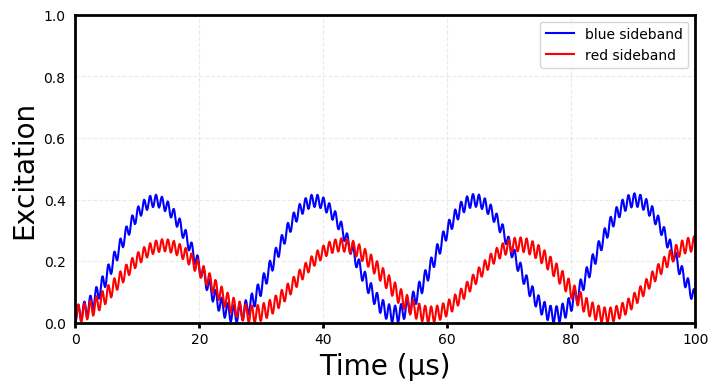
The large detuning is coming almost entirely from an AC Stark shift off of the carrier transition.
We can confirm this by using they rwa_cutoff keyword in the hamiltonian function. Setting rwa_cutoff=x, will neglect all terms in the Hamiltonian that oscillate faster than x.
Since the vibrational mode frequency has been set to 1 MHz, if we set rwa_cutoff=1e5, we should neglect the carrier Stark shift in our simulation:
# tune laser frequency to blue sideband
detuning!(laser, ν)
h = hamiltonian(chamber, timescale=1e-6, rwa_cutoff=1e-5) # set rwa_cutoff here
@time tout, sol_blue = timeevolution.schroedinger_dynamic(tspan, ψ1, h)
# tune laser frequency to red sideband
detuning!(laser, -ν)
h = hamiltonian(chamber, timescale=1e-6, rwa_cutoff=1e-5) # set rwa_cutoff here
@time tout, sol_red = timeevolution.schroedinger_dynamic(tspan, ψ1, h)
ex_blue = expect(ionprojector(chamber, "D"), sol_blue)
ex_red = expect(ionprojector(chamber, "D"), sol_red)
plt.plot(tout, ex_blue, color="blue", label="blue sideband")
plt.plot(tout, ex_red, color="red", label="red sideband")
plt.xlim(tout[1], tout[end])
plt.ylim(0, 1)
plt.legend(loc=1)
plt.ylabel("Excitation")
plt.xlabel("Time (μs)");
0.009923 seconds (16.59 k allocations: 935.641 KiB)
0.009140 seconds (13.23 k allocations: 845.641 KiB)
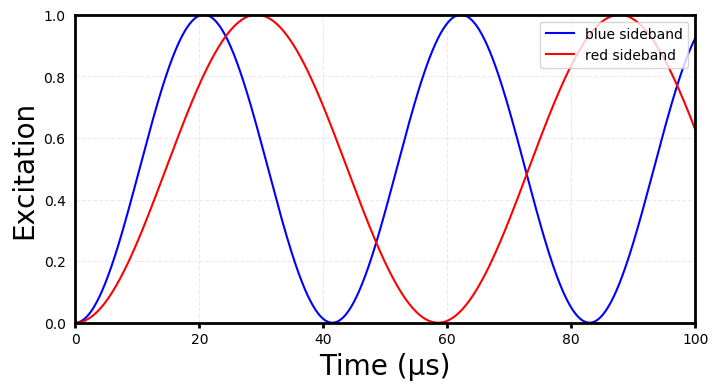
A final note about the rwa_cutoff:
If hamiltonian knows that you’re not performing an RWA, it can do some optimization to reduce the number of internal functions that need to be evaluated, leading to faster performance. We can let it know that we’re not performing an RWA by setting rwa_cutoff=Inf (this is the default value).
To reiterate: if you’re not performing an RWA, then setting rwa_cutoff equal to Inf, rather than some arbitrarily large value, will lead to faster performance.
Time-dependent parameters#
All of the parameters denoted as time-dependent in the Hamiltonian equation at the start of this notebook can be set to arbitrary single-valued functions by the user. This can be useful for things like optimal control and modeling noise.
Below we’ll give a couple of examples of this.
First we note that the Stark shift-induced detuning of the BSB Rabi flop in the previous section can be compensated by adding an additional detuning to the laser:
# add additional detuning to BSB to compensate for carrier Stark shift
detuning!(laser, ν-31e3)
tspan = 0:0.1:60
h = hamiltonian(chamber, timescale=1e-6)
@time tout, sol = timeevolution.schroedinger_dynamic(tspan, ψ0, h)
ex = expect(ionprojector(chamber, "D"), sol)
plt.plot(tout, ex)
plt.xlim(tout[1], tout[end])
plt.ylim(0, 1)
plt.ylabel("Excitation")
plt.xlabel("Time (μs)");
14.691759 seconds (745.27 k allocations: 19.802 MiB)
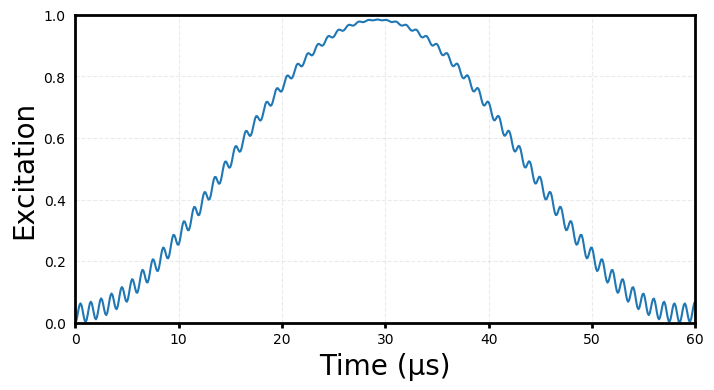
However, we’re still stuck with the off-resonant population oscillations from the carrier transition. It turns out we can eliminate these by ramping up the amplitude of the laser at the beginning of the simulation.
Such a ramp can be set with the intensity of the laser:
# get previous value of intensity field strength
I = intensity_from_pitime(1, 2e-6, 1, ("S", "D"), chamber)
# Simple amplitude ramping function
function Ω_4us(t)
if t < 4
return sin(2π * t / 16)^2
else
return 1
end
end
intensity!(laser, t -> I*Ω_4us(t)^2);
h = hamiltonian(chamber, timescale=1e-6)
@time tout, sol = timeevolution.schroedinger_dynamic(tspan, ψ0, h)
ex = expect(ionprojector(chamber, "D"), sol)
plt.plot(tout, ex)
plt.plot(tout, @.(Ω_4us(tout)/2), linestyle="--", label="scaled ramp")
plt.xlim(tout[1], tout[end])
plt.ylim(0, 1)
plt.legend(loc=1)
plt.ylabel("Excitation")
plt.xlabel("Time (μs)");
30.452336 seconds (1.38 M allocations: 32.742 MiB, 0.22% compilation time)

To be a bit more succinct we can use a Julia anonymous function:
# To make things interesting let's also reduce the ramp time from 4 μs to 1 μs
Ω_1us = t -> t < 1 ? sin(2π * t / 4)^2 : 1
intensity!(laser, t -> I*Ω_1us(t)^2);
h = hamiltonian(chamber, timescale=1e-6)
@time tout, sol = timeevolution.schroedinger_dynamic(tspan, ψ0, h)
ex = expect(ionprojector(chamber, "D"), sol)
plt.plot(tout, ex)
plt.plot(tout, @.(Ω_1us(tout)/2), linestyle="--", label="scaled ramp")
plt.xlim(tout[1], tout[end])
plt.ylim(0, 1)
plt.legend(loc=1)
plt.ylabel("Excitation")
plt.xlabel("Time (μs)");
43.024349 seconds (1.52 M allocations: 35.659 MiB, 3.81% compilation time)
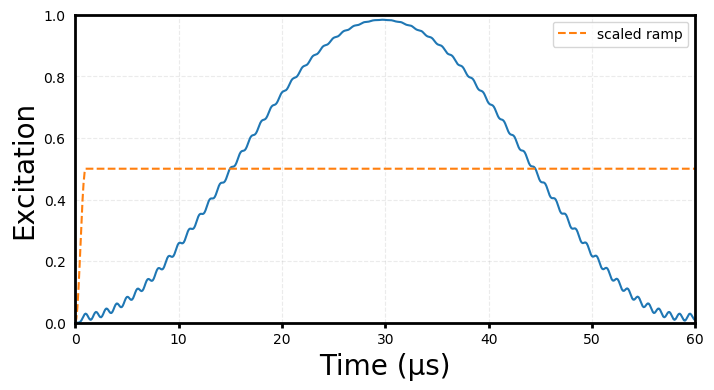
Even with just a 1 μs ramp, we already see noticeable reduction of the fast oscillations.
As an applied example of a time-dependent laser frequency, we can simulate Rapid Adiabatic Passage or RAP [WHK+07], which can be used for robust preparation of the ion in an excited state.
We’ll linearly sweep through the laser’s frequency from -150 kHz to +150 kHz detuned from the carrier transition
in a time Tp
# the length of time of the frequency chirp in μs
Tp = 150
# Δϕ is equal to half the detuning range we will chirp the laser over multiplied by the timescale (1e-6)
Δϕ = 2π * 150e-3
# Set the frequency chirp
phase!(laser, t -> (-Δϕ + (2Δϕ / Tp) * t) * t);
We’ll also ramp the Rabi frequency:
I = intensity_from_pitime(1, 6.5e-6, 1, ("S", "D"), chamber)
tr = 33
function Ω(t)
if t < tr
return sin(2π * t / 4tr)^2
elseif tr <= t <= 150 - tr
return 1
elseif 150 - tr < t < 150
return sin(2π * (t - 150) / 4tr)^2
else
return 0
end
end
intensity!(laser, t -> I*Ω(t)^2);
# Set the B-field to match the value in the reference
bfield!(chamber, 2.9e-4)
# set detuning back to carrier at new magnetic field
wavelength_from_transition!(laser, ca, ("S", "D"), chamber);
detuning!(laser, 0)
tspan = 0:0.1:175
h = hamiltonian(chamber, timescale=1e-6)
@time tout, sol = timeevolution.schroedinger_dynamic(tspan, ψ0, h)
ex = expect(ionprojector(chamber, "D"), sol)
ϕ = phase(laser)
plt.plot(tout, ex, lw=3)
plt.plot(
tout, @.(Ω(tout)/2),
linestyle="--", label="scaled amplitude profile"
)
plt.plot(
tout, @.(ϕ(tout) / (2Δϕ * tout)),
linestyle="--", label="scaled frequency profile"
)
plt.xlim(tout[1], tout[end])
plt.legend(loc=1)
plt.ylim(0, 1)
plt.ylabel("Excitation")
plt.xlabel("Time (μs)");
127.910394 seconds (3.56 M allocations: 71.396 MiB, 9.63% compilation time)
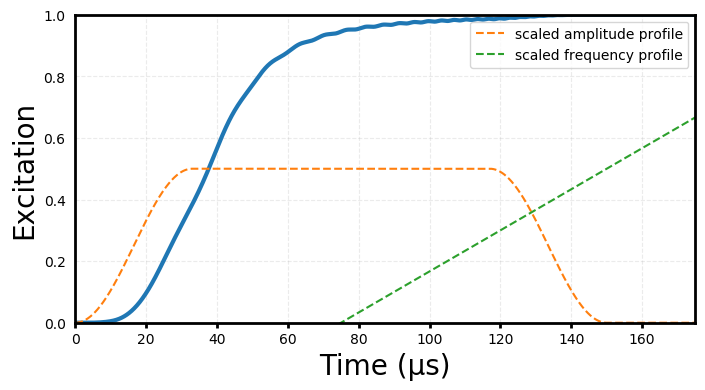
detuning_range = 2π*1e-6 .* collect(1e3:2e4:2e6)
pops = Vector{Float64}(undef, 0)
for Δϕ in detuning_range
phase!(laser, t -> (-Δϕ/2 + (Δϕ / Tp) * t) * t)
h = hamiltonian(chamber, timescale=1e-6)
_, sol = timeevolution.schroedinger_dynamic(tspan, ψ0, h)
push!(pops, real(expect(ionprojector(chamber, "D"), sol)[end]))
end
plt.plot(@.(detuning_range * 1e3), pops, lw=3, color="C1")
plt.xlim(-10, detuning_range[end] * 1e3)
plt.ylim(0, 1.01)
plt.ylabel("Final Excited State\nPopulation")
plt.xlabel("detuning range (kHz)");
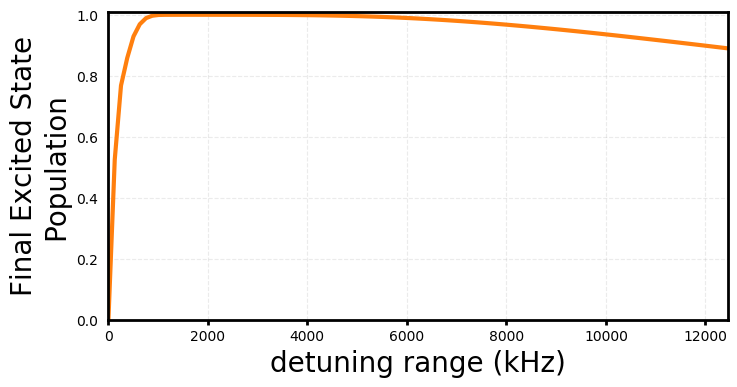
# get rid of frequency chirp
phase!(laser, 0);
Noise (in progress)#
QuantumOptics has several solvers that can incorporate noise. Here are some examples for using these with IonSim.
First we’ll consider decoherence of the state \(|\psi\rangle = |S\rangle + |D\rangle\) due to B-field fluctuations, which can be implemented by setting T.δB which has units of Tesla (we won’t do it here, but this value can also be made time-dependent).
# using StochasticDiffEq
# tspan = collect(0:10.:30000)
# β = 1e-2
# σ = √(2β)
# w = StochasticDiffEq.OrnsteinUhlenbeckProcess(β, 0.0, σ, 0.0, 0.0)
# w.dt = 0.1;
# plt.title("O-U noise")
# warray = [w(t)[1] for t in tspan]
# plt.plot(tspan, warray)
# plt.show()
# using DSP: periodogram
# sample_rate = (length(tspan) - 1)/tspan[end]
# pwarray = periodogram(warray, fs=sample_rate)
# freqs = pwarray.freq
# abs_freqs = freqs .* 1e6
# powers = pwarray.power
# N = 50
# for i in 1:N-1
# w = StochasticDiffEq.OrnsteinUhlenbeckProcess(β, 0.0, σ, 0.0, 0.0)
# w.dt = 0.1
# warray = [w(t)[1] for t in tspan]
# powers .+= periodogram(warray, fs=sample_rate).power
# end
# powers ./= powers[2]
# plt.loglog(abs_freqs, powers, label="numerical")
# ou_psd(f) = σ^2 / (β^2 + (2π * f)^2)
# plt.loglog(abs_freqs, ou_psd.(freqs) ./ ou_psd(freqs[2]), color="C1", label="theoretical", ls="--")
# plt.ylabel("relative power")
# plt.xlabel("frequency [Hz]")
# plt.title("O-U PSD")
# plt.ylim(10e-3, 2)
# plt.xlim(250, 2e4)
# plt.legend()
# plt.show()
# # Let's create a new Ion with the right energy sublevels for a Δm = 2 transition
# C = Ca40([("S1/2", -1/2), ("D5/2", -5/2)])
# set_sublevel_alias!(C, Dict("S" => ("S1/2", -1/2),
# "D" => ("D5/2", -5/2)))
# # Create a new Trap with the new Ion
# chain = LinearChain(
# ions=[C], com_frequencies=(x=3e6,y=3e6,z=1e6),
# vibrational_modes=(;z=[1]))
# T = Trap(configuration=chain, B=4e-4, Bhat=ẑ, δB=0, lasers=[L]);
# # Redefine mode for new trap
# mode = T.configuration.vibrational_modes.z[1];
# # Display sublevels of new ion
# sublevels(T.configuration.ions[1])
# # we're not paying attention to the vibrational mode here, so we set its dimension to 1,
# # effectively ignoring it
# mode.N = 1
# # construct a zero operator
# L.E = 0
# T.δB = 0.1
# h = hamiltonian(T)
# # construct noise operator
# T.δB = 5e-1
# hs = hamiltonian(T)
# hsvec = (t, ψ) -> [hs(t, ψ)]
# ψi_ion = (C["S"] + C["D"])/√2
# ψi = ψi_ion ⊗ mode[0]
# Ntraj = 100
# ex = zero(tspan)
# # iterate SDE solver Ntraj times and average results
# w = StochasticDiffEq.OrnsteinUhlenbeckProcess(β, 0.0, σ, 0.0, 0.0)
# for i in 1:Ntraj
# if mod(i,10) == 1
# println(i)
# end
# tout, sol = stochastic.schroedinger_dynamic(tspan, ψi, h, hsvec, noise=w,
# normalize_state=true, dt=0.1)
# ex .+= real.(expect(dm(ψi_ion) ⊗ one(mode), sol)) ./ Ntraj
# end
# plt.plot(tspan, ex, color="C0", label="Simulated Contrast")
# plt.xlim(tspan[1], tspan[end])
# plt.ylim(0, 1)
# plt.legend()
# plt.ylabel("Ramsey Signal")
# plt.xlabel("Time (μs)")
# plt.show()
We can compare the same magnitude of B-field fluctuations for a white PSD. We could use the stochastic solver again, but instead let’s use a Lindblad master equation solver:
# γ1 = hs(1.0, 0).data[1, 1]/40
# γ2 = hs(1.0, 0).data[2, 2]/40
# rates = 1/4π .* abs.([γ1, γ2])
# hs1 = C["S"] ⊗ C["S"]' ⊗ one(mode)
# hs2 = C["D"] ⊗ C["D"]' ⊗ one(mode)
# tspan = collect(0:1.:30000)
# @time tout, sol = timeevolution.master(tspan, dm(ψi), h(1.0, 0.0), [hs1, hs2], rates=rates, maxiters=1e8)
# ex = expect(dm(ψi_ion) ⊗ one(mode), sol)
# plt.plot(tspan, ex)
# plt.xlim(tspan[1], tspan[end])
# plt.ylim(0, 1)
# plt.ylabel("Ramsey Contrast")
# plt.xlabel("Time (μs)")
# plt.show()
A brute force way to include shot-to-shot noise on a simulated parameter is to just run the simulation multiple times – with the parameter pulled each time from some probability distribution – and then average the results.
As an example, we consider fluctuations of the laser’s electric field \(E\) such that \(E \sim \mathcal{N}(\bar{E}, \delta E^2)\), then we should expect a Gaussian decay profile \(e^{-t^2 / 2\tau^2}\) with: \(1/\tau = \delta E\bigg(\frac{\partial\omega}{\partial E}\bigg)\).
# # Move back to using Δm = 0 transition
# C = Ca40([("S1/2", -1/2), ("D5/2", -1/2)])
# set_sublevel_alias!(C, Dict("S" => ("S1/2", -1/2),
# "D" => ("D5/2", -1/2)))
# chain = LinearChain(
# ions=[C], com_frequencies=(x=3e6,y=3e6,z=1e6),
# vibrational_modes=(;z=[1]))
# T = Trap(configuration=chain, B=4e-4, Bhat=ẑ, δB=0, lasers=[L]);
# mode = T.configuration.vibrational_modes.z[1];
# T.B = 4e-4
# T.δB = 0
# # recompute the wavelength
# L.λ = transitionwavelength(C, ("S", "D"), T);
# E = Efield_from_pi_time(2e-6, T, 1, 1, ("S", "D"))
# tspan = 0:0.1:60
# # average over Ntraj runs
# Ntraj = 1000
# δE = 0.025E
# ex = zero(tspan)
# ψi = C["S"] ⊗ mode[0]
# @time begin
# for i in 1:Ntraj
# ΔE = δE * randn()
# L.E = E + ΔE
# h = hamiltonian(T)
# tout, sol = timeevolution.schroedinger_dynamic(tspan, ψi, h)
# ex .+= expect(ionprojector(T, "D"), sol) ./ Ntraj
# end
# end
# # compute expected τ
# hz_per_E = 1 / Efield_from_rabi_frequency(1, ẑ, L, C, ("S", "D"))
# τ_us = 1e6 / (2π * δE * hz_per_E)
# plt.plot(tspan, ex)
# plt.plot(
# tspan, @.((1 + exp(-(tspan / (√2 * τ_us))^2))/2),
# color="C1", ls="--", label="Gaussian Envelope"
# )
# plt.plot(
# tspan, @.((1 - exp(-(tspan / (√2 * τ_us))^2))/2),
# color="C1", ls="--"
# )
# plt.xlim(tspan[1], tspan[end])
# plt.ylim(0, 1)
# plt.legend()
# plt.ylabel("Excitation")
# plt.xlabel("Time (μs)");
Adding more than a single ion/laser#
Adding addtional lasers and ions to the system is straightforward. Here we’ll see how that’s done by modeling a Mølmer-Sørensen interaction [SorensenMolmer00], which can be used to entangle the electronic states of multiple ions and requires at least two laser tones and vibrational mode.
# Construct the system
ca = Ca40([("S1/2", -1/2, "S"), ("D5/2", -1/2, "D")])
laser1 = Laser()
laser2 = Laser()
chain = LinearChain(
ions=[ca, ca],
comfrequencies=(x=3e6,y=3e6,z=1e6),
selectedmodes=(;z=[1])
)
chamber = Chamber(iontrap=chain, B=4e-4, Bhat=(x̂ + ẑ)/√2, lasers=[laser1, laser2]);
# Set the laser parameters
ϵ = 40e3
d = 80 # corrects for AC stark shift from single-photon coupling to sidebands
mode = zmodes(chamber)[1]
ν = frequency(mode)
wavelength_from_transition!(laser1, ca, ("S", "D"), chamber)
detuning!(laser1, ν + ϵ - d)
polarization!(laser1, x̂)
wavevector!(laser1, ẑ)
wavelength_from_transition!(laser2, ca, ("S", "D"), chamber)
detuning!(laser2, -ν - ϵ + d)
polarization!(laser2, x̂)
wavevector!(laser2, ẑ)
modecutoff!(mode, 5)
η = abs(lambdicke(mode, ca, laser1))
Ω1 = √(1e3 * ϵ) / η # This will give a 1kHz MS strength, since coupling goes like (ηΩ)^2/ϵ
intensity_from_rabifrequency!(1, Ω1, 1, ("S", "D"), chamber)
intensity_from_rabifrequency!(2, Ω1, 1, ("S", "D"), chamber);
ψi = ca["S"] ⊗ ca["S"] ⊗ mode[0]; # initial state
We can compare this to the analytical result:
?analytical.molmersorensen2ion
molmersorensen2ion(tspan, Ω::Real, ν::Real, δ::Real, η::Real, n̄::Real)
Assumes vibrational mode starts in a thermal state with: \(\langle a^\dagger a\rangle = n̄\)
and ions start in doubly ground state. Returns (ρgg, ρee), the population in the doubly
ground and doubly excited state, respectively. [Ω], [ν], [δ] = Hz
ex = analytical.molmersorensen2ion(tspan, 1e-6Ω1, 1e-6ν, 1e-6ν + 1e-6ϵ, η, 0)
plt.plot(tspan, SS)
plt.plot(tspan, DD)
plt.plot(tspan, ex[1], ls="--")
plt.plot(tspan, ex[2], ls="--")
plt.ylim(0, 1);

We can also see what happens when the vibrational mode starts out in a thermal state:
modecutoff!(mode, 15)
ρi = dm(ionstate(chamber, ["S", "S"])) ⊗ thermalstate(mode, 2) # thermal state
h = hamiltonian(chamber, timescale=1e-6, rwa_cutoff=5e5)
tspan = collect(0:0.25:1000)
@time tout, sol = timeevolution.schroedinger_dynamic(tspan, ρi, h)
SS = expect(ionprojector(chamber, "S", "S"), sol)
DD = expect(ionprojector(chamber, "D", "D"), sol)
SD = expect(ionprojector(chamber, "S", "D"), sol)
DS = expect(ionprojector(chamber, "D", "S"), sol)
plt.plot(tout, SS, label="SS")
plt.plot(tout, DD, label="DD")
plt.plot(tout, SD, label="SD")
plt.plot(tout, DS, label="DS")
ex = analytical.molmersorensen2ion(tspan, 1e-6Ω1, 1e-6ν, 1e-6ν + 1e-6ϵ, η, 2)
plt.plot(tspan, ex[1], ls="--")
plt.plot(tspan, ex[2], ls="--")
plt.xlim(tout[1], tout[end])
plt.ylim(0, 1)
plt.legend(loc=1)
plt.xlabel("Time (μs)");
48.651787 seconds (14.40 M allocations: 1.388 GiB, 6.77% gc time, 1.51% compilation time)

There is some discrepancy because of the Lamb-Dicke approximation made in the analytical solution.
Adding more ions/lasers/modes is done in the same way.
chain = LinearChain(
ions=[ca, ca, ca, ca, ca, ca],
comfrequencies=(x=3e6,y=3e6,z=1e6),
selectedmodes=(;z=[1])
)
chamber = Chamber(iontrap=chain, B=4e-4, Bhat=(x̂ + ẑ)/√2, lasers=[laser1, laser2])
globalbeam!(laser1, chamber) # set laser1 to shine equally on all ions
globalbeam!(laser2, chamber) # set laser2 to shine equally on all ions
mode = zmodes(chamber)[1]
modecutoff!(mode, 5)
η = abs(lambdicke(mode, ca, laser1))
Ω2 = √(1e3 * ϵ) / η
intensity_from_rabifrequency!(1, Ω2, 1, ("S", "D"), chamber)
intensity_from_rabifrequency!(2, Ω2, 1, ("S", "D"), chamber)
ψi = ionstate(chamber, repeat(["S"], 6)) ⊗ mode[0]
h = hamiltonian(chamber, timescale=1e-6, rwa_cutoff=5e5)
tspan = 0:0.25:2000
@time tout, sol = timeevolution.schroedinger_dynamic(tspan, ψi, h);
S = expect(ionprojector(chamber, repeat(["S"], 6)...), sol)
D = expect(ionprojector(chamber, repeat(["D"], 6)...), sol)
plt.plot(tout, S, label="SSSSSS")
plt.plot(tout, D, label="DDDDDD")
plt.xlim(tout[1], tout[end])
plt.ylim(0, 1)
plt.legend(loc=1)
plt.title("6 Ion Molmer Sorensen")
plt.xlabel("Time (μs)");
22.104712 seconds (18.30 M allocations: 1.273 GiB, 2.82% gc time, 2.77% compilation time)
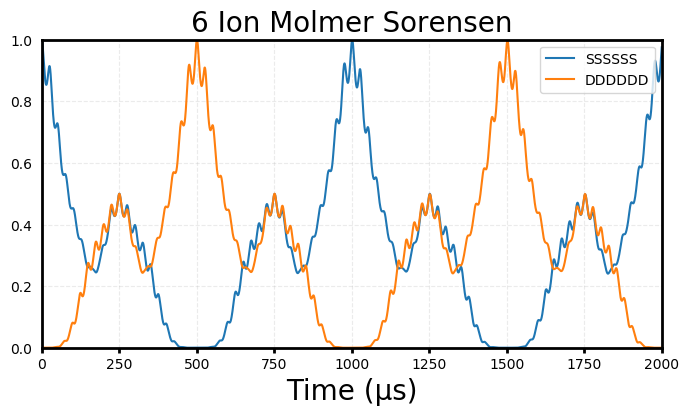
IonSim.PhysicalConstants#
You can find some commonly used physical constants in IonSim.PhysicalConstants. They support all normal algebraic operations.
const pc = IonSim.PhysicalConstants;
pc.ħ
1.0545718e-34 [m²kg/s]
pc.c
2.99792458e8 [m/s]
println(pc.μB / pc.ħ)
println(pc.ħ + pc.c)
println(pc.α^pc.α)
8.794100069810324e10
2.99792458e8
0.9647321772836126
Bibliography#
- KramerPOR18
Sebastian Krämer, David Plankensteiner, Laurin Ostermann, and Helmut Ritsch. Quantumoptics. jl: a julia framework for simulating open quantum systems. Computer Physics Communications, 227:109–116, 2018.
- SorensenMolmer00
Anders Sørensen and Klaus Mølmer. Entanglement and quantum computation with ions in thermal motion. Phys. Rev. A, 62:022311, Jul 2000. URL: https://link.aps.org/doi/10.1103/PhysRevA.62.022311, doi:10.1103/PhysRevA.62.022311.
- WHK+07
Chr. Wunderlich, Th. Hannemann, T. Körber, H. Häffner, Ch. Roos, W. Hänsel, R. Blatt, and F. Schmidt-Kaler. Robust state preparation of a single trapped ion by adiabatic passage. Journal of Modern Optics, 54(11):1541–1549, 2007. URL: https://doi.org/10.1080/09500340600741082, arXiv:https://doi.org/10.1080/09500340600741082, doi:10.1080/09500340600741082.
